In Search of Water: the Suiban-jo Castle Ruins

Two hundred meters above the nearest source of water seems a strange place for a well. But climb up Mt. Higashiyama and there it is, at the tippy top of the mountain almost, just downslope from where Hayashi Castle used to stand.
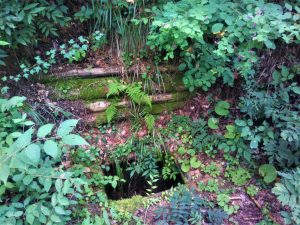
Kiyomune Ogasawara built Hayashi-jo in 1446 for two reasons. One, the flatland castle of Igawa-jo, where the Ogasawara clan had ruled Shinano for over a hundred years, was looking increasingly susceptible in the face of mounting tensions between the two Ogasawara factions. Two, the rivers that protected Igawa-jo had a habit of overflowing.
Relocating to the top of a mountain must have seemed like a good idea on both counts – until they got all moved in and went to get a glass of water and realized the closest river was the Susukigawa, down at the bottom of the mountain.
The solution, of course, lie in constructing a well. But digging a two-hundred-meter hole was apparently too ludicrous an endeavor for Lord Kiyomune. The evidence – what little there is of it – points to the idea that he instead provided water for his castle by digging a simple mile-long waterway through the mountains. Then he built another castle to protect that waterway and keep the water flowing.
Piece of cake.
That castle, Suiban-jo, was built on a ridge just to the east of Higashiyama. Today we are going to go check it out as we search for the source of Hayashi-jo’s water.
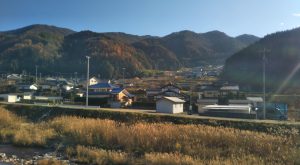
By the way, if you are the rare intrepid type to actually make the trek to Suiban-jo, then you deserve nothing less than a few solid tips in finding your way here. Get started by renting a bicycle and point that puppy east. Pedal along the Susukigawa River on the right (i.e. south) side and hang a right when you come to this sign for the Hashikura neighborhood.
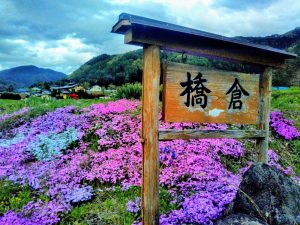
This side road ends at a T less than 200 meters up. Bang a left and proceed as straight as possible along the gently snaking road for about 400 meters until you come to this corner (you’ll see the sign and the red fire hose box from the back as you approach).
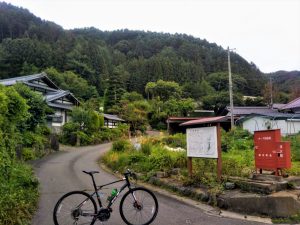
Turn right and pedal upslope to here:
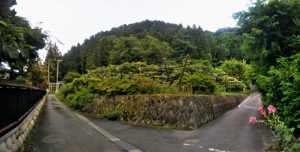
Look left and you’ll see that torii (gate) to Minamigata Suwa Jinja Shrine, believed to date from the Choroku Era (1457-1460). Initially related to Hakusan Jinja, this shrine housing the deity duo of Tateminakata-no-mikoto and Tajikarao-no-mikoto switched its spiritual ties to Togakushi Shrine before becoming associated with Suwa Taisha Grand Shrine. Whether Tateminakata-no-mikoto and Tajikarao-no-mikoto care which shrine it’s tied to is up for debate.
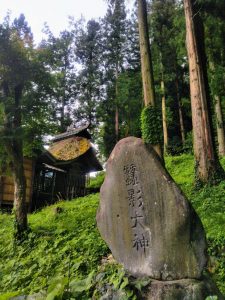
Say a prayer and backtrack to the corner and continue uphill. It’ll barely be 50 meters before the road ends, but keep going. Yes it looks like you’re heading straight into someone’s backyard – and you might be, I’m not sure since I didn’t bother asking before pushing my bike through the grass. (You might want to leave your rent-a-cycle there at the edge of the pavement. Your call.)
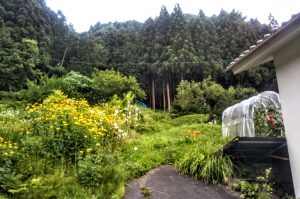
Walk straight ahead, then follow the natural path curving left along the edge of the woods. Before you know it you’ll be staring at a small arrow-shaped sign pointing through the fence.
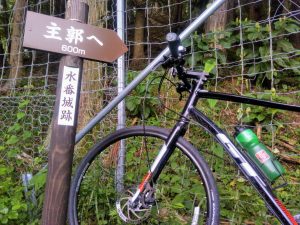
Don’t let the yellow and red sign turn you off, it just says close the gate behind you.
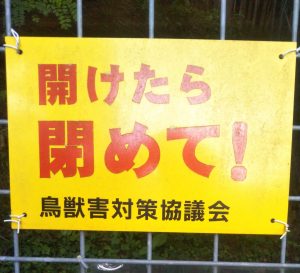
Through the gate and a dozen steps along the fence on your right and you come to a corner in the fence. Ahead the trail looks like it leads nicely through the woods to the right. But this is wrong. Another dozen steps and you should notice a trail off to your left, zig-zagging uphill. You may see a wooden torii through the trees. If so, you are on the right track. Head up.
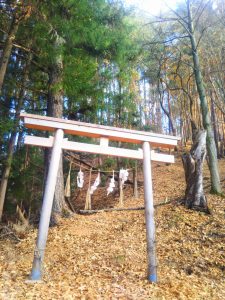
Through the torii and up more zig-zags and we come to Akiba Shrine, another modest affair with a long and storied history.

A series of fires ravaged this area between 1798-1800, compelling the villagers to build a shrine to pray for an end to their ongoing misfortune. The millstones that form the shrine’s foundation are said to be from one (or more) of the houses that had burned down. The ornamental roof tiles on the ground may have similar origins, though the sign nearby doesn’t say. The sign does tell us that in the Edo Era there were four additional shrines standing here in a line across the grounds of Akiba Shrine, but they were eventually combined into the main shrine. Akiba Jinja was rebuilt in 2017 by students of architecture from the Matsumoto School of Technology.
Another arrow-shaped sign tells us we are now just 300 meters from the site of Suiban-jo. The trail leads right, away from Akiba Shrine and (of course) uphill, in a straight shot to the shukaku.
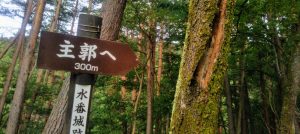
Along the way you’ll see a couple more signs:
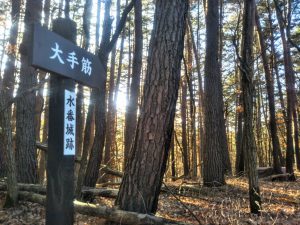
大手筋 – “Ote-suji” – The ridge to the right, a feature of the mountain well-suited for defensive purposes.
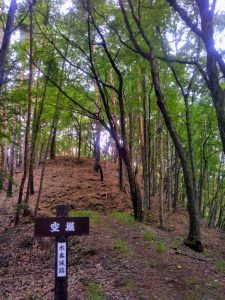
空堀 – “Akibori” – Just before and just after this sign are curious and evidently man-made hollows in the earth, like dry moats (a nice way of saying ditches) meant to add to the defensive character of the castle. (You may have actually noticed another moat/ditch on your way to this point.)
From these hollows the trail rises, steep and unclear, up to the shukaku, the place where the castle’s main structure stood. You’ll know you’ve arrived by the remnants of the stone walls that were conceivably much more imposing when they were new.
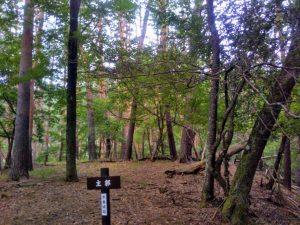
Behind this shukaku the earth dips down, then rises and levels off. The steep slopes on either side provided more defensive strength. So did another moat as well as another ridge, Karamete-suji (搦手筋). If you look you’ll notice a path leading along the ridge and downward. Feel free to check it out, intrepid specimen, but you may be getting more than you bargained for if you try to find out just where it goes.
Which may have been the attitude of the people charged with finding the actual source of Hayashi-jo’s water. It is accepted that rain and snowmelt flowing down through this swath of mountainside was directed via a snaking waterway dug into the contours of the canyons and ridges, leading ultimately to that well up on Higashiyama. But resources plainly admit that proper (adequately-funded?) investigation into finding evidence of this waterway have yet to be undertaken.
If you find anything, let me know.
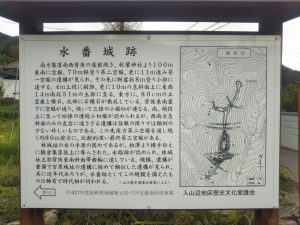
And just in case the directions above are unclear, here’s where you can find Minamigata Suwa Shrine:
[googlemaps https://www.google.com/maps/embed?pb=!1m18!1m12!1m3!1d7057.462546659992!2d138.00845560395325!3d36.22808732549606!2m3!1f0!2f0!3f0!3m2!1i1024!2i768!4f13.1!3m3!1m2!1s0x601d08ddc6d15555%3A0x6d6ad6ee6ce91f22!2z5Y2X5pa56KuP6Kiq56S-!5e0!3m2!1sen!2sjp!4v1606290690013!5m2!1sen!2sjp&w=600&h=450]